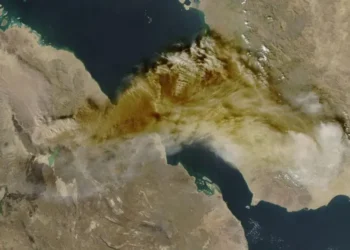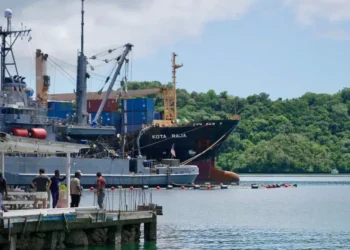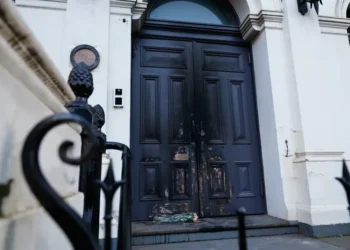Three Missing, Over 50 Rescued After Typhoon Halong’s Remnants Ravage Alaska’s Western Coast
Published: October 14, 2025, 21:25 EDT
Rescue Efforts Underway as Alaska Faces Storm Devastation
Three people remain missing in western Alaska after the remnants of Typhoon Halong tore through coastal communities over the weekend, unleashing hurricane-force winds and flooding that swept away homes and left widespread destruction. Authorities confirmed that more than 50 people were rescued, including several who were airlifted from rooftops amid rising floodwaters.
The U.S. Coast Guard and Alaska State Troopers have been leading rescue and recovery operations, describing the situation in the hardest-hit areas as “absolute devastation.”
Communities Struggle in Aftermath of Historic Storm
Officials warned that the road to recovery will be long, especially as winter approaches. In the villages of Kipnuk and Kwigillingok—two of the most severely impacted areas—emergency shelters have been established in local schools to house displaced residents.
Capt. Christopher Culpepper of the U.S. Coast Guard said the scale of damage across these villages was “unlike anything seen in recent memory.” The storm’s impact included destroyed homes, ruined food supplies, and power outages that have left hundreds struggling to meet basic needs.
According to the National Weather Service (NWS), the storm brought powerful surges and flooding to multiple coastal regions, with sustained winds exceeding 70 mph (112 kph).
Rescue Missions Save Dozens Amid Dangerous Conditions
Alaska State Troopers confirmed that at least 51 residents and two dogs were rescued from Kipnuk and Kwigillingok. However, three individuals remain unaccounted for in Kwigillingok. Authorities are also working to verify unconfirmed reports of missing people in Kipnuk.
Most residents took refuge in local schools as floodwaters swept through their villages, according to the Coastal Villages Region Fund, a regional nonprofit aiding affected communities. Emergency response teams are continuing search efforts using helicopters and boats to reach isolated areas cut off by floodwaters.
‘The Worst I’ve Ever Seen’: Residents Describe the Storm’s Fury
Residents in several communities recounted harrowing experiences as the storm hit. Jamie Jenkins, 42, from the nearby village of Napakiak, said she had “never seen anything like it.” Her mother’s home shifted off its foundation, and another neighbor’s house was flooded before they evacuated by boat to a local school.
“Practically the whole community was there,” Jenkins said. “The men went house to house in boats picking up anyone still trapped.” She has since volunteered to help distribute food and supplies to families in need.
In Kotlik, resident Adaline Pete said she witnessed winds so strong that an unoccupied house next door was flipped over. “We were lucky,” she said. “Our home held up, but it was terrifying.”
Climate Resilience and Federal Support Under Scrutiny
Alaska’s senators, Lisa Murkowski and Dan Sullivan, pledged continued support for disaster relief and climate resilience projects. During a press briefing with Governor Mike Dunleavy, the senators emphasized the urgency of securing federal funds for infrastructure and coastal protection.
Senator Sullivan stated that Alaska’s congressional delegation is working to ensure both the administration and Congress “understand the importance of resilience funding for rural Alaska.”
Earlier this year, the Federal Emergency Management Agency (FEMA) announced plans to phase out a key disaster mitigation program — a decision now being challenged in court. Murkowski warned that Alaska cannot afford delays in erosion and flood-prevention projects.
“We’re seeing storms grow stronger and more frequent,” Murkowski said. “The time to act is now. These mitigation efforts take years to implement, and we’re already running out of time.”
Rising Threats of Erosion and Permafrost Melt
Kwigillingok, a predominantly Alaska Native community of roughly 380 residents on the Kuskokwim Bay coast, has long been vulnerable to flooding and erosion. A 2022 report from the Alaska Institute for Justice identified the village’s relocation as an urgent priority due to worsening flood risks and melting permafrost.
Scientists have warned that Alaska’s coastal infrastructure faces increasing threats from climate change, including shoreline erosion and thawing permafrost that destabilize homes, roads, and fuel storage facilities.
Severe Weather Impacts Across the U.S.
The remnants of Typhoon Halong also brought extreme weather to other parts of the United States. In New York City, strong winds killed a woman after a falling solar panel struck her, prompting the cancellation of the annual Columbus Day Parade.
In Arizona, rescuers in the Phoenix area recovered the body of a man whose truck was swept away by floodwaters, while California emergency crews pre-positioned helicopters and bulldozers in anticipation of mudslides in wildfire burn zones.
The National Weather Service issued a flood watch for much of Southern California beginning Monday evening, forecasting several inches of rain and up to three feet of snow in higher elevations of the Sierra Nevada.
Long Road Ahead for Recovery
State officials have begun coordinating with federal agencies to assess damage and provide emergency funding. Relief organizations are distributing supplies to isolated communities, while the Coast Guard continues to conduct aerial surveys of flood-damaged regions.
Governor Dunleavy called on Alaskans to remain resilient and united in the face of hardship. “These storms remind us how strong our communities are,” he said. “But we will need long-term support to rebuild what’s been lost.”
This article was rewritten by JournosNews.com based on verified reporting from trusted sources. The content has been independently reviewed, fact-checked, and edited for accuracy, neutrality, tone, and global readability in accordance with Google News and AdSense standards.
All opinions, quotes, or statements from contributors, experts, or sourced organizations do not necessarily reflect the views of JournosNews.com. JournosNews.com maintains full editorial independence from any external funders, sponsors, or organizations.
Stay informed with JournosNews.com — your trusted source for verified global reporting and in-depth analysis. Follow us on Google News, BlueSky, and X for real-time updates.














